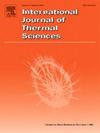Hybrid treated graphene-epoxy coating for spray cooling enhancement of light-emitting diode
IF 4.9
2区 工程技术
Q1 ENGINEERING, MECHANICAL
International Journal of Thermal Sciences
Pub Date : 2025-03-07
DOI:10.1016/j.ijthermalsci.2025.109831
引用次数: 0
Abstract
Thermally-treated graphene-epoxy coatings not only allow rapid water permeation but also increase the durability of the coating. Therefore, these coatings have been extensively used in phase-change heat-transfer applications. In this study, we reported a further improvement in water permeation rate of graphene-epoxy coating by using a hybrid-treatment, which involves a sequential treatment consisting of plasma-treatment and thermal-treatment. With the hybrid-treatment, we observe up to 99% and 87% decrease in water permeation time, when compare to untreated and thermally-treated graphene-epoxy coatings, respectively. This decrease in water permeation time can be primarily attributed to a dramatic increase in surface roughness (125% and 90% for the untreated and thermally-treated coatings) as well as the increase in silver concentration on the coating surface, leading to rapid spreading of the droplet. By depositing a single droplet on the untreated and hybrid-treated graphene-epoxy coatings, it can be seen that by increasing the temperature of the graphene-epoxy coatings to that near the boiling point of water can lead to higher increase in heat removal rates. Using a simple spray system for the cooling of a light-emitting diode that operates at the boiling point of water, we observe 38% and 25% increase of heat transfer coefficients when the deionized aerosols deposited on the hybrid-treated coatings compared to the uncoated surface and thermal-treated coating, respectively. Since the atmospheric pressure plasma can be generated easily, the cost to conduct plasma-treatment is relatively low compared to thermal-treatment, particularly that via corona discharge.
求助全文
约1分钟内获得全文
求助全文
来源期刊

International Journal of Thermal Sciences
工程技术-工程:机械
CiteScore
8.10
自引率
11.10%
发文量
531
审稿时长
55 days
期刊介绍:
The International Journal of Thermal Sciences is a journal devoted to the publication of fundamental studies on the physics of transfer processes in general, with an emphasis on thermal aspects and also applied research on various processes, energy systems and the environment. Articles are published in English and French, and are subject to peer review.
The fundamental subjects considered within the scope of the journal are:
* Heat and relevant mass transfer at all scales (nano, micro and macro) and in all types of material (heterogeneous, composites, biological,...) and fluid flow
* Forced, natural or mixed convection in reactive or non-reactive media
* Single or multi–phase fluid flow with or without phase change
* Near–and far–field radiative heat transfer
* Combined modes of heat transfer in complex systems (for example, plasmas, biological, geological,...)
* Multiscale modelling
The applied research topics include:
* Heat exchangers, heat pipes, cooling processes
* Transport phenomena taking place in industrial processes (chemical, food and agricultural, metallurgical, space and aeronautical, automobile industries)
* Nano–and micro–technology for energy, space, biosystems and devices
* Heat transport analysis in advanced systems
* Impact of energy–related processes on environment, and emerging energy systems
The study of thermophysical properties of materials and fluids, thermal measurement techniques, inverse methods, and the developments of experimental methods are within the scope of the International Journal of Thermal Sciences which also covers the modelling, and numerical methods applied to thermal transfer.
 求助内容:
求助内容: 应助结果提醒方式:
应助结果提醒方式:


